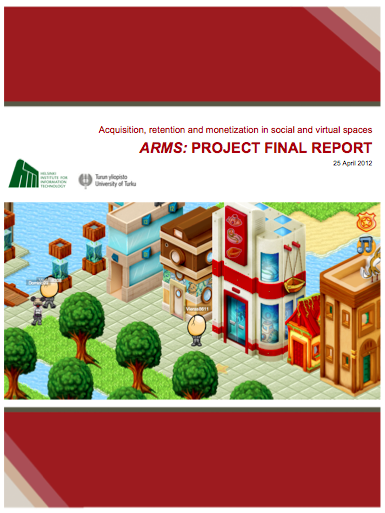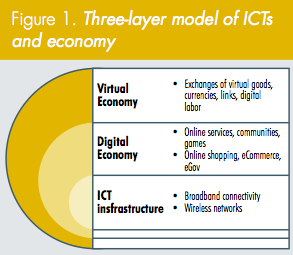Today’s HIIT Gamification of Services Seminar in Helsinki also doubles as the final seminar of a research project called ARMS: Acquisition, Retention and Monetization in Virtual and Social Spaces, in which I’ve had the pleasure of working during the past couple of years. We are publishing the final report of the project here on VERN. Enjoy!
ARMS: Project Final Report – Introduction
The ARMS research project – short for Acquisition, Retention and Monetization of Virtual and Social Spaces – started in fall 2009 as a part of Tekes’s (The Finnish Funding Agency for Technology and Innovation) Spaces and Places research program.
The mission of ARMS was two-folded. First, Tekes’s program called for projects that would study the cross-section of three sorts of spaces: the virtual space, the physical space and the social space. ARMS did exactly this. The scope of our project ranged from virtual hangouts, to social networking services and to media companies. On a conceptual level, it even spanned brick and mortar businesses. The second mission was an internal one, set by ARMS’s project proposal in summer 2009: to investigate how strategies drawn from the virtual space could be used to enhance customer acquisition, retention and monetization in other contexts. In hindsight, this goal setting was timely: the term gamification became popular in the latter half of 2010, resulting in a surge of interest in the topics that ARMS was already studying.
The project was implemented in three phases. In the first phase, we began with an exploratory investigation of virtual design patterns used in virtual worlds, social networking services and games. The second phase consisted of identifying theories behind these patterns from social sciences, economics and marketing. In the third phase, these patterns were investigated in case studies of multiple services.
In terms of publications, the project produced nine articles in scientific journals and 11 conference and workshop papers, in addition to some that are still in review. Comprehensive internal technical reports were also created to serve as tools for subsequent research and as brainstorming documents for the project’s company partners. The cooperation with the industry partners was very positive and insightful throughout the entire project and the feedback we have received leads us to believe that the cooperation was likewise regarded as valuable by the companies.
This document summarizes the project’s results through 12 short essays, each describing one research area that resulted in one or more publications. The essays introduce the problem area, summarize some of the key results and highlight implications for business and design. At the end of each summary essay, there are links to relevant publications and presentations that interested readers can use to delve deeper into the subjects.
The ARMS project had a strong international dimension. Vili Lehdonvirta worked as a visiting scientist at the University of Tokyo’s Interfaculty Initiative in Information Studies, and Kai Huotari worked as a visiting scholar at the University of California Berkeley School of Information. We forged important new links, collaborating closely with the Virtual Worlds Observatory, a consortium of U.S. social scientists led by professor Dmitri Williams at University of Southern California. We also collaborated closely with our long-standing partners at Waseda University, Japan, lead by professor Tatsuo Nakajima, as well as with the project’s Iceland-based partner CCP Games and Sulake’s California office. These international exchanges continued our tradition of working with top research institutes in Japan and in the United States, and allowed HIIT to further strengthen its position as one of the global leaders in virtual economy research.
We would like to thank Tekes as well as our industry partners CCP Games, Frosmo, Ironstar Helsinki, Maxisat, Nokia, Palmu and Sulake for their financial support and for their curiosity. We would also like to thank the University of Turku, our co-research partner in this project, for seamless and insightful cooperation. And last but not least let us thank our brilliant colleagues who have worked with us on this project: Veikko Eranti, Juho Hamari, Matti Nelimarkka, Matti Näsi, adj. prof. Olli Pitkänen, professor Pekka Räsänen, Outi Sarpila, Juha Tolvanen, and professor Marko Turpeinen.
Kai Huotari Vili Lehdonvirta
Project manager Report editor
Helsinki Institute for Information Technology HIIT
Aalto University / Univerity of Helsinki, Finland



